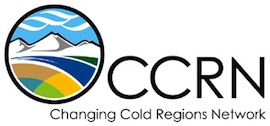
Dr. Aaron Berg
Department Geography, University of Guelph
 519-824-4120 ext. 58514
519-824-4120 ext. 58514 aberg@uoguelph.ca
aberg@uoguelph.ca  https://www.uoguelph.ca/geography/faculty/berg/
https://www.uoguelph.ca/geography/faculty/berg/
Research areas
Our research completed during the CCRN program focused on Themes A, B and C. Theme A, focused on the development of inventories of observable change over the CCRN domain. Our research responded to this theme through the development of new techniques for the monitoring of environmental changes using remote sensing. Key highlights included a study by former MSc. student Michael Merchant who presented an approach for boreal wetland type classification using data from Canada’s RADARSAT-2 satellite. A second former MSc. student, Olivia Carpino documented rates of permafrost thaw over the past 40 years using remote sensing data over an expansive region extending from North Eastern British Columbia through the southern North West Territories (over a 300 km extent). Her research illustrated significant losses in permafrost within peatlands over the region.
Within research theme B (diagnosis and understanding of local changes), our research focused on the development and analysis of networks for monitoring climate and soil moisture. Soil moisture monitoring networks were established within Southern Saskatchewan, the boreal forest and in an arctic tundra environment. The data itself was used primarily for further understanding of how to use remotely sensed information on the backscatter or emission of energy in microwave frequencies for estimation of soil moisture (from sensors on space-based platforms). Several evaluations of soil moisture estimates from different satellite platforms (NASA’s soil moisture active passive sensor (SMAP), the European Space Agencies Soil Moisture and Ocean Salinity mission, NASA’s Aquarius satellite and the Canadian RADARSAT-2 satellite) were conducted using these networks established over the CCRN domain. Results suggest that the soil moisture products derived from remote sensing have higher accuracy in the agricultural domains than boreal forest or tundra regions, suggesting areas for future improvement. Notable research includes work by former MSc. student Elizabeth Wrona, that presented the first assessment of the NASA SMAP soil moisture retrieval in an arctic tundra environment.
The datasets developed as part of Theme B were well utilized for our work focused on Theme C (Upscaling for improved atmospheric modelling and river basin scale prediction). Here our work focused on the assessment of land surface models for estimation of soil moisture. We also worked on the improvement of soil moisture estimates within land surface models through the assimilation (or updating) of model estimates with data observed from satellites. Numerous publications across our work in all of these themes is documented in the activities reports shown below.